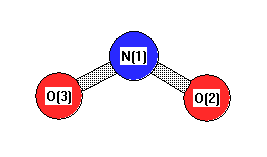Vibrational Frequencies calculated at B2PLYP=FULL/STO-3G
| Mode Number |
Symmetry |
Frequency
(cm-1) |
Scaled Frequency
(cm-1) |
IR Intensities
(km mol-1) |
Raman Act
(Å4/u) |
Dep P |
Dep U |
|---|
| 1 |
A1 |
1218 |
1218 |
2.05 |
7599920.00 |
0.33 |
0.50 |
| 2 |
A1 |
619 |
619 |
1.55 |
6985455.00 |
0.33 |
0.50 |
| 3 |
B2 |
6208 |
6208 |
198384.60 |
0.00 |
0.75 |
0.86 |
Unscaled Zero Point Vibrational Energy (zpe) 4022.3 cm
-1
Scaled (by 1) Zero Point Vibrational Energy (zpe) 4022.3 cm
-1
See section
III.C.1 List or set vibrational scaling factors
to change the scale factors used here.
See section
III.C.2
Calculate a vibrational scaling factor for a given set of molecules
to determine the least squares best scaling factor.
